
The black-winged red bishop, formerly known in southern Africa as the fire-crowned bishop, is a resident breeding bird species in tropical Africa from Senegal to Sudan and south to Angola, Tanzania, Zimbabwe and Mozambique.
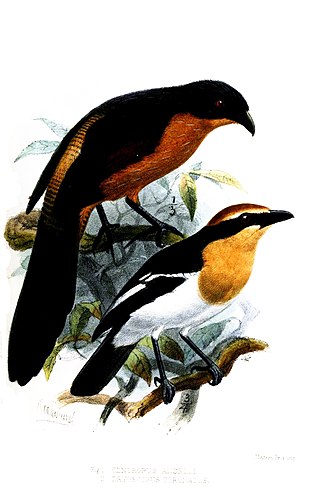
The Gabon coucal is a species of cuckoo in the family Cuculidae. It is mainly found in Gabon but also occurs in neighboring areas of Cameroon, Angola, the Central African Republic, the western Congo Basin and Equatorial Guinea.

The blue-headed coucal is a species of cuckoo in the family Cuculidae. It is native to tropical central Africa where its typical habitat is swamps, river banks, forest edges and generally wet locations. It is a common bird with a wide range, and the International Union for Conservation of Nature has rated its conservation status as being of "least concern".

The akun eagle-owl is a species of owl in the family Strigidae and is native to the African tropical rainforest.

Fraser's eagle-owl is a species of African owl in the family Strigidae. It is named after the British zoologist Louis Fraser.

Shelley's eagle-owl is a species of owl in the family Strigidae. Despite its large size, it is a very little-known, rarely studied owl that occurs in very small numbers. A specimen was photographed in the wild for the first time on 16 October 2021 in the Atewa Range Forest Reserve in southeastern Ghana.

The bare-shanked screech owl is a species of owl in the family Strigidae. It is a large owl that feeds at night in forests and lives in a family size group, even during breeding season. The owl's range is only in Costa Rica, Panama, and far northwestern Colombia. The owl preys on large insects, shrews, and small rodents.

The Balsas screech owl is a species of owl in the family Strigidae. It is endemic to Mexico.

Pel's fishing owl is a large species of owl in the family Strigidae, found in Africa. It lives near rivers and lakes, and feeds nocturnally on fish and frogs snatched from the surface of lakes and rivers. The species prefers slow-moving rivers with large, overhanging trees to roost in and forage from. It nests in hollows and the forks of large trees. Though as many as two eggs are laid, often only one chick is raised.
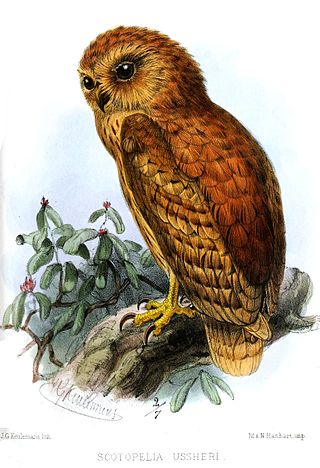
The rufous fishing owl, rufous-backed fishing-owl or Ussher's fishing owl, is a species of owl in the family Strigidae. It is endemic to west Africa, where it is a highly localised resident along forest rivers.

The brown-hooded kingfisher is a species of bird in the subfamily Halcyoninae, the tree kingfishers. It has a brown head and blackish and turquoise wings. It is found in Sub-Saharan Africa, living in woodland, scrubland, forest edges, and also suburban areas. The International Union for Conservation of Nature (IUCN) has assessed it as being of least concern.

The rufous-tailed palm thrush is a species of bird in the family Muscicapidae.

The whistling cisticola is a species of bird in the Cisticolidae family. It can be found in several regions within Africa, such as Angola, Benin, Burundi, Cameroon, Central African Republic, Republic of the Congo, Ivory Coast, Gabon, Gambia, Ghana, Guinea, Kenya, Liberia, Mali, Nigeria, Senegal, Sierra Leone, Sudan, Togo, Uganda, and Zambia. Its natural habitats include subtropical or tropical dry forests, dry savanna, and moist savanna.
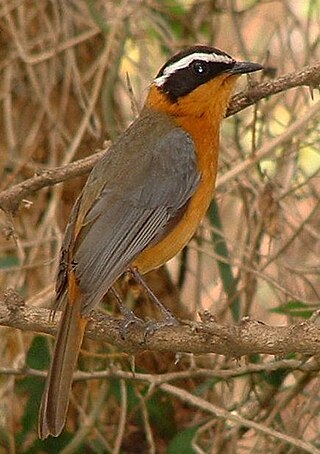
The white-browed robin-chat, also known as Heuglin's robin, is a species of bird in the family Muscicapidae. Found in east, central and southern Africa, its natural habitats include riverine forest and thickets, and it is also found near humans. The IUCN classifies it as a least-concern species.

The swamp boubou, also known as the Gabon boubou, is a species of bird in the Malaconotidae or bushshrike family. It is native to western and southern Central Africa. In the north of their range, savannah thickets constitute an important part of their habitat, while in the south they are strongly associated with river systems and marshes, for which they are named. The pair bond appears to be maintained by duetting, which in the south is generally synchronous or overlapping. It is most similar to L. major major, with which it perhaps hybridizes, but the underpart plumage is immaculate white, while the female contributes a ratchet-like note to the duet.

Brazza's martin is a passerine bird in the swallow family, Hirundinidae. It is 12 centimeters (4.7 in) long with grey-brown upperparts, heavily black-streaked white underparts, and a brownish tint to the breast plumage. The sexes are similar, but juvenile birds have more diffuse breast streaking and reddish-brown edges to the feathers of the back and wings. The song consists of a series of short notes of increasing frequency, followed by a complex buzz that is sometimes completed by a number of clicks.

The yellow-crested woodpecker, also known as the golden-crowned woodpecker, is a species of bird in the family Picidae. Some taxonomic authorities place this species in Dendropicos. Its typical habitat is wet tropical forest and it is found in Angola, Cameroon, Central African Republic, Republic of the Congo, Democratic Republic of the Congo, Gabon, Kenya, Nigeria, South Sudan, Tanzania and Uganda.
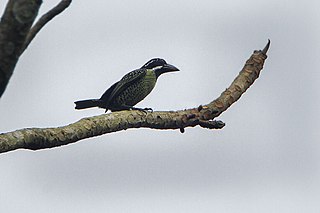
The hairy-breasted barbet is a species of bird in the family Lybiidae. It is found throughout the Africa tropical rainforest.

Vermiculation is a surface pattern of dense but irregular lines, so called from the Latin vermiculus meaning "little worm" because the shapes resemble worms, worm-casts, or worm tracks in mud or wet sand. The word may be used in a number of contexts for patterns that have little in common. The adjective vermiculated is more often used than the noun.
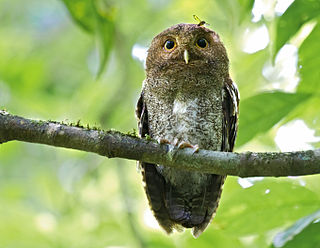
The vermiculated screech owl, is a subspecies of Middle American screech owl, or possibly separate species of owl in the family Strigidae. It is found in Costa Rica, Nicaragua, and Panama.





















